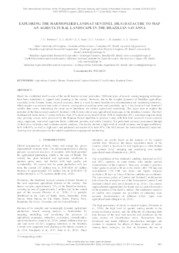Exploring the Harmonized Landsat Sentinel (HLS) datacube to map an agricultural landscape in the Brazilian savanna.
Exploring the Harmonized Landsat Sentinel (HLS) datacube to map an agricultural landscape in the Brazilian savanna.
Author(s): PARREIRAS, T. C.; BOLFE, E. L.; SANO, E. E.; VICTORIA, D. de C.; SANCHES, I. D.; VICENTE, L. E.
Summary: ABSTRACT: Brazil has established itself as one of the world leaders in food production. Different types of remote sensing mapping techniques have been undertaken to support rural planning in the country. However, due to the complex dynamics of Brazilian agriculture, especially in the Cerrado biome (tropical savanna), there is a need for more feasible crop discrimination and monitoring initiatives, which require a consistent time series of remote sensing data at medium meter and potentially up to 3 day Landsat 8 and Sentinel-2 satellite time series, minimizing the cloud cover limitations for rainfed agricultural monitoring. This paper aims to explore the potential of the Harmonized Landsat 8 Sentinel-2 (HLS) data cube to map agricultural landscapes in the Brazilian Cerrado. The HLS multispectral bands from 27 scenes with less than 10% cloud cover, from October 2020 to September 2021, encompassing one entire crop growing season, were processed by the Random Forest algorithm to produce a map with four land use/cover classes (annual crops, sugarcane, renovated sugarcane fields, cultivated pastures, and native Cerrado). We performed accuracy assessment through 10-fold cross-validation and confusion matrix analyses. The results showed a high level of overall accuracy and Kappa coefficient, both with 99%, as well as high user's and producer's accuracies of at least 99%. The HLS dataset has been continuously improved, showing very promising results for rainfed agricultural mapping and monitoring.
Publication year: 2022
Types of publication: Journal article
Observation
Some of Embrapa's publications are published as ePub files. To read them, use or download one of the following free software options to your computer or mobile device. Android: Google Play Books; IOS: iBooks; Windows and Linux: Calibre.
Access other publications
Access the Agricultural Research Database (BDPA) to consult Embrapa's full library collection and records.
Visit Embrapa Bookstore to purchase books and other publications sold by Embrapa.

